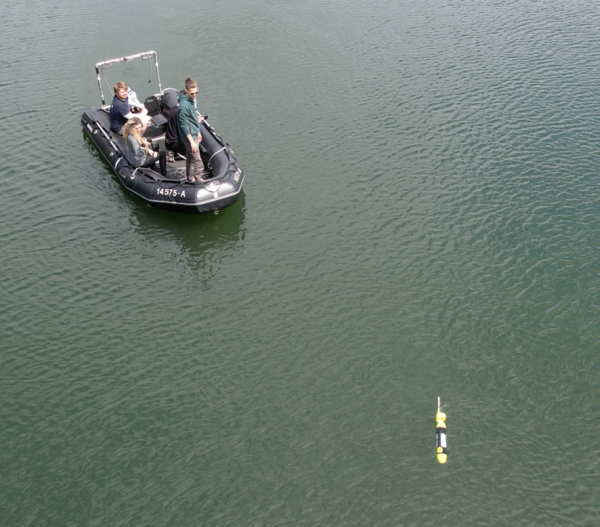EMSO ERIC is pleased to announce the start of the first project coordinated by external users within the EMSO Physical Access Program!
The campaign of this Physical Access Project, TRIPLE – Vtest, is awarded through a competitive tender to the Center for Marine Environmental Sciences (MARUM), University of Bremen, Germany, and will take place at OBSEA, the shallow water EMSO Regional Facility located offshore Vilanova i la Geltru, near Barcelona. With the technological and logistical support of the OBSEA Regional Team, the MARUM group will add elements of robotic observation to extend the capacity of ocean permanent installations collecting information to design an observation strategy for quality data acquisition combining stationary and mobile measuring assets.


MARUM researchers from the University of Bremen testing sensors for underwater vehicles at the OBSEA facility. Photo: SARTI team
EMSO Physical Access and OBSEA in a nutshell
The objective of the EMSO Physical Access Program is to offer physical access to EMSO Facilities where users’ devices can be installed, including sensors, instruments, systems, new technologies and where new procedures/experiments can be tested/take place.
The EMSO Regional Facility OBSEA, operated by Universitat Politècnica de Catalunya (UPC), is a permanent underwater cabled observatory located near Barcelona, at 20 m water depth, that facilitates affordable access for testing of different types of measurement instruments, communication modules or scientific experiments, and enables real-time communication with the deployed devices. The devices can be deployed either at the seabed or at the surface buoy.
SCIENTIFIC FRAMEWORK
The world’s oceans are increasingly coming under stress due to the combined effect of sudden changes in the water column properties and long-term trends that are related to climate change. Getting a comprehensive picture of the health status of the oceans is of utmost importance to quantify the impact of these processes, make forecasts of ongoing developments and if possible, take mitigation steps.
The planned field campaign at OBSEA is aiming at extending existing ocean observing capabilities by adding a mobile robotic platform to the existing infrastructure and by that extending the coverage of the observing system. Those mobile robots combined with Artificial Intelligence (AI) methods are key elements to enhance existing ocean observing systems.
MARUM – Center for Marine Environmental Sciences at the University of Bremen has received funding from EMSO to carry out the field campaign.
Innovative Method Development
Combining mobile robotic systems with fixed observing installations has been intensively explored in the past. The innovation that the planned experiment shall bring is related to the application of recently emerged methods and technologies, i.e., a miniaturized Autonomous Underwater Vehicle (AUV), that allows for easy deployment and recovery together with a robust control and mission planning system. Based on such kind of versatile and reliable system, it will be explored how the data that are collected at OBSEA can be complemented with measurements in regions of up to 10 km around the location of the installation. From these measurements, new observing strategies shall be derived that will lead to a more comprehensive picture of the region of Eastern Spain/Catalonia and similar locations.
Another aspect that will be addressed is how measurements at a specific spot are representative of processes evolving on a local, regional or global scale. Judging on that is only possible with a deep knowledge on observations collected in the past over a long-time frame.
Artificial Intelligence in the context of ocean observations
Artificial intelligence in this framework is heavily relying on a data record that is long enough so that it can be used to for instance to train neural networks for deep learning. Those data have to cover all relevant events in an enough rate of occurrence to make the identification of those events reliable. This will be another topic addressed by the field campaign at OBSEA.
Impact
The results of the field measuring campaign will be relevant to develop a concept how mobile and fixed observing platforms can be combined in the most efficient manner. Miniaturized Autonomous Underwater Vehicles (AUV) will probably get a more prominent role in future observing programs like for measuring campaigns in polar regions. Therefore, scientists at MARUM are currently developing a new type of AUV hardware in the frame of the TRIPLE-nanoAUV project. The new miniaturised AUV will enable the investigation of areas that are not accessible with conventional vehicles, like under ice shields in Polar regions and thereby completely new observing approaches will be made possible.

Testing the miniaturized AUV in the University Lake in Bremen/Germany. Photo: Christoph Waldmann/MARUM
Involved Institutions
MARUM – Center for Marine Environmental Sciences, University of Bremen, Germany
UPC – Universitat Politècnica de Catalunya, Spain
RWTH – RWTH Aachen University, Germany
To know more about MARUM, visit the website
For more details about the OBSEA Regional Facility, click here
Have a look at the EMSO Physical Access Call 2023, there is still time to apply!


